¿Te interesa realizar un curso online de tècnicas del tejido en telar con Anna Champeney?Si te interesa aprender técnicas de diseño y tejido en telar de bajo lizo online, escríbanos y suscribir a nuestro boletín.
 Contacta con nosotros |  Spanish basket maker Lluis Grau has just spent the whole morning heating wild cherry wood poles over an open fire in the darkness of his traditional bodega or stone hut, in the Ribeira Sacra, rural Ourense, north Spain. After heating them he splits them lengthwise by hand, following the natural grain of the wood to form splints. Four neatly tied bundles of splints of wood are the result, each classified according to length. Lluis will then plane the splits using a two-handled knife – a drawknife – into smooth, even strips which are then woven together to form baskets. Lluis is one of the few traditional basketmakers in the whole of Galicia, north Spain, who still have the necessary knowledge and skills to make these baskets. Spanish basket maker Lluis Grau has just spent the whole morning heating wild cherry wood poles over an open fire in the darkness of his traditional bodega or stone hut, in the Ribeira Sacra, rural Ourense, north Spain. After heating them he splits them lengthwise by hand, following the natural grain of the wood to form splints. Four neatly tied bundles of splints of wood are the result, each classified according to length. Lluis will then plane the splits using a two-handled knife – a drawknife – into smooth, even strips which are then woven together to form baskets. Lluis is one of the few traditional basketmakers in the whole of Galicia, north Spain, who still have the necessary knowledge and skills to make these baskets.
The four bundles of wood will be enough to make around a dozen baskets for Lluis´ annual exhibition held in August in his workshop. Lluis´ production each year is limited and as well as selling direct from his workshops he is often invited to exhibit in international exhibitions. At the moment one of his pieces is on show in the prestigious Joahannes Larsen Museet in Denmark, in the “Kirsebaer-Kurv 2010” (Cherry Basket) exhibition.  Just across the way from where Lluis is working Anna, his partner, a hand-weaver, has finished weaving a length of cloth and has cut it from the loom. The resulting roll is satisfyingly heavy and includes enough glossy linen fabric to make several glossy linen babycapes as well as decorative stripey linen cloth made from a completely different grade of linen yarn which is very rustic in feel. To make a woven textile on a handloom today requires a minimum of ten separate processes and just setting up the loom can take a week´s work. Anna´s weave workshop is the only one in the whole of the Ribeira Sacra area of Galicia, and Lluis is one of the few basketmakers left too. Both represent traditions of making objects by hand which are centuries´ old. Although none have younger successors both have taught many pupils, both at their workshops and internationally and are committed to teaching and researching, to pass on their skills, as well as producing work for sale. Just across the way from where Lluis is working Anna, his partner, a hand-weaver, has finished weaving a length of cloth and has cut it from the loom. The resulting roll is satisfyingly heavy and includes enough glossy linen fabric to make several glossy linen babycapes as well as decorative stripey linen cloth made from a completely different grade of linen yarn which is very rustic in feel. To make a woven textile on a handloom today requires a minimum of ten separate processes and just setting up the loom can take a week´s work. Anna´s weave workshop is the only one in the whole of the Ribeira Sacra area of Galicia, and Lluis is one of the few basketmakers left too. Both represent traditions of making objects by hand which are centuries´ old. Although none have younger successors both have taught many pupils, both at their workshops and internationally and are committed to teaching and researching, to pass on their skills, as well as producing work for sale.
Factfile Summer Exhibition and Open Workshops 2010 – Anna and Lluis both open their workshops to the public during the month of August – Opening Hours and Map / How to Get There – when they stage their annual selling exhibition of craftwork. Both makers also accept commissions and sales by email. Entry to the exhibition and sale area is free and guided tours with the makers are also available every day until 45 minutes before closing time. 2.50€ per person (Tel. 669 600 620). The rest of the year the workshops are closed to the public except by prior appointment, for guided visits (Tel. 669 600 620). Basketry and Weaving Holidays and Tuition – Anna Champeney Estudio Textil and Lluis Grau, Basketmaker, offer personalized tuition as well as a programme of basketry and weaving courses during the year. Where to Stay – Accommodation in the Ribeira Sacra – The nearest place to stay is Casa dos Artesans, Lluis and Anna´s rustic holiday cottage, decorated with their own baskets and hand-loomed textiles. The cottage has two double bedrooms. Ribeira Sacra handwoven textile and basketry workshops are worth a visit so after you have “done” the boat trip and visited the monasteries, follow our route around the picturesque village of Cristosende for a truly different experience of the Ribeira Sacra. A visit to this scenic hamlet in August not only means you can visit the open village craft studios to see and buy hand-made textiles and rare baskets and have a guided visit. In the same village you can also visit the family-run bodega, go for a shady stroll with some stunning scenery (print out the information below) and then finish up in the Cristosende manor house bar for a drink, ice-cream or even a meal (reserve beforehand). There are few such pretty villages in the locality of such a small size which offer you so many possibilities. Let us know how you get on by adding a comment! Map of How to Get to Cristosende About Cristosende (15 minutes from Castro Caldelas, overlooking the River Sil) 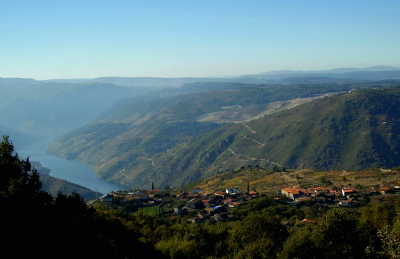 Cristosende is arguably one of the prettiest in the Ribeira Sacra (Ourense), with many tiny stone bodegas still used by local people to make wine and stunning views directly over the River Sil Canyon with its steeply-terraced, hand-worked, vineyards which produce the local mencia and godello wines. The village is not an artificial tourist village, however, but a real working village, with all the small businesses run by local families. It experiences a brief buzz during the annual fiestas, at the beginning of August, and for the rest of the year it is a haven of peace and quiet, with fewer than 40 all-year round inhabitants. Cristosende is arguably one of the prettiest in the Ribeira Sacra (Ourense), with many tiny stone bodegas still used by local people to make wine and stunning views directly over the River Sil Canyon with its steeply-terraced, hand-worked, vineyards which produce the local mencia and godello wines. The village is not an artificial tourist village, however, but a real working village, with all the small businesses run by local families. It experiences a brief buzz during the annual fiestas, at the beginning of August, and for the rest of the year it is a haven of peace and quiet, with fewer than 40 all-year round inhabitants.
Suggestions for things to do in Cristosende in the Riberia Sacra this August 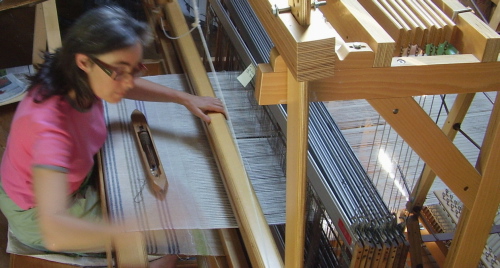 Activity 1 – Visit to the only weaving and basketry workshops in the whole of the Ribeira Sacra – Anna Champeney Textile Studio and Lluis Grau Basketry Activity 1 – Visit to the only weaving and basketry workshops in the whole of the Ribeira Sacra – Anna Champeney Textile Studio and Lluis Grau Basketry
Opening Hours –1 – 31 August 2010 – Tuesday – Sunday – 10.30 – 1.30pm / 6.00 – 8.30pm.
- Free access to shop and exhibition areas.
- Guided visits during opening hours (up to 45 minutes before closing time) on request. (Cost: 2,5€ per individual, group tarifs according to numbers)
Rest of the Year – closed to the public except for guided tours / visits by appointment (T. +34 669 600 620)  Products and Description: Products and Description:
- Unusual hand-woven traditional designs and techniques and range of own-label products.
- Rare Spanish baskets with local designs from the Ribeira Sacra, Galicia and the north of Spain.
- Opportunity for Guided Workshop Tours (August)
About Weaving and Basket Making in the Ribeira Sacra – Weaving and basketry were both traditional Spanish crafts that were part of everyday life in the Ribeira Sacra in Galicia just 50 years ago, with hundreds of weavers and basketmakers at work. Anna Champeney and Lluis Grau keep the tradicions alive and develop them further in their small but beautifully-restored craft workshops. The workshops have information panels and offer guided tours on request. More about Anna Champeney Textile Studio in Cristosende, About Lluis Grau Basketmaker Activity 2 – Walking route in and around Cristosende (A Teixeira) (about 30 minutes) 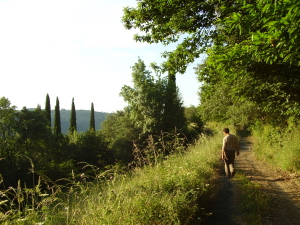 A relaxing stroll which is a circular route along peaceful country lanes, some of which is through beautifully shady sweet chestnut groves. Print this route out as it is not signposted. It is very easy to follow and has wonderful views over the village, the vineyards and the River Sil itself. Walking is, perhaps, the best way to experience the Ribeira Sacra, and a refreshing change to car-based tourism. A relaxing stroll which is a circular route along peaceful country lanes, some of which is through beautifully shady sweet chestnut groves. Print this route out as it is not signposted. It is very easy to follow and has wonderful views over the village, the vineyards and the River Sil itself. Walking is, perhaps, the best way to experience the Ribeira Sacra, and a refreshing change to car-based tourism.
Starting point: Communal public wash-place (locals still wash clothes and rugs in this roofed water-tank) in the centre of the village (a roofed water tank near the signpost to the Anna Champeney Textile Workshop). You can drink the spring water from the more modern of two water fountains here.
- Walk out of the village along the country lane, past the village recycling point, towards A Teixeira. Pretty views of Cristosende.
- Shortly after the road curves to the left and begins to climb you take a steep asphalted country lane on the right. This takes you by the hamlet of O Barrio and past Casa Pital with its majestic cypress trees.
- Continue walking straight on through shady sweet chestnut groves until you come to a –T-junction, where you will see a village spring set into a rock on the right. This is drinkable.
- Then turn right, down hairpin bends leading back into Cristosende. Enjoy the wonderful views, this time over the River Sil Canyon itself.
- This takes you back into the village of Cristosende. Take the first right turn into the village to pass by the village winery, Viña Pederneira. Continue on down through the village to the wash-place.
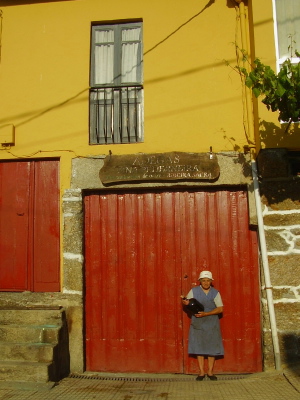 Activity 3: Viña Pederneira (D.O. Ribeira Sacra) – The village winery Activity 3: Viña Pederneira (D.O. Ribeira Sacra) – The village winery
- Opening hours – whenever a member of the family is at home (although avoid siesta time!), rather than working in the vineyards. If the bodega door is not open then don´t be afraid to shout “Hola” loudly.
- Products: Gift packs of 3 bottles of mencia and godello wine. Wine boxes also available. Ask about local aguardiente (the delicious local spirit made from distilling grapeskins, flavoured with coffee or herbs)
- Description: The small family-run winery or bodega in Cristosende makes wine exclusively from its own mencia and godello grapes. Although small bodegas like Viña Perderneira don´t have the public profile of the larger, more commercial wineries you will see publicised in tourist brochures and in large road signs, they represent the truly authentic face of wine-making tradition of the Ribeira Sacra. Again, unlike some of the other wineries which apparently buy up grapes from other regions, all the wine from Viña Perderneira has been made from local vineyards in and around Crisotsende.
Activity 4 – Eating and Drinking in Cristosende 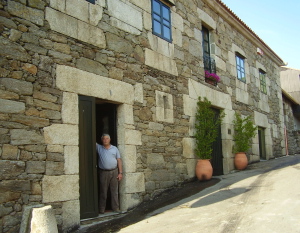 After your visit to the craft workshops you can enjoy a drink or a meal (with prior reservation – (T. +34 988 20 75 29) at the attractive village manor house, the Casa Grande. The walled courtyard is refreshingly cool in summer. Another alternative is to bring your own picnic and sit out at one of the village merenderos (picnic areas), some of which have drinking fountains. Please remember to take your rubbish with you and leave the marble tables clean (Cristosende villagers like to play cards there on summer afternoons). After your visit to the craft workshops you can enjoy a drink or a meal (with prior reservation – (T. +34 988 20 75 29) at the attractive village manor house, the Casa Grande. The walled courtyard is refreshingly cool in summer. Another alternative is to bring your own picnic and sit out at one of the village merenderos (picnic areas), some of which have drinking fountains. Please remember to take your rubbish with you and leave the marble tables clean (Cristosende villagers like to play cards there on summer afternoons).
Staying in Cristosende – Tourist Accommodation in Cristosende The village has several options for staying longer including craft holidays, should you wish to return another time:
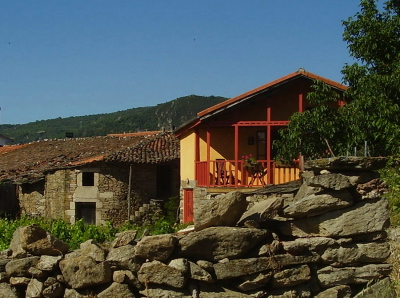 Casa dos Artesans holiday cottage (shown in photo) is ideal if you are looking for privacy, value-for-money, and space of your own. Advance bookings only. 2 spacious bedrooms. Sleeps 2 – 5 people. (585€ per week + 13.50€ for extra single bed for 5th person). (T. +34 669 600 620) Casa dos Artesans Holiday Cottage Casa dos Artesans holiday cottage (shown in photo) is ideal if you are looking for privacy, value-for-money, and space of your own. Advance bookings only. 2 spacious bedrooms. Sleeps 2 – 5 people. (585€ per week + 13.50€ for extra single bed for 5th person). (T. +34 669 600 620) Casa dos Artesans Holiday Cottage Craft Holidays – Anna Champeney, textile weaver, and Lluis Grau, basket weaver, offer residential craft holidays and courses of up to 3 weeks duration so you can combine a stay in the Ribeira Sacra with learning how to make your own hand-woven textile or basket. Craft Holidays – Anna Champeney, textile weaver, and Lluis Grau, basket weaver, offer residential craft holidays and courses of up to 3 weeks duration so you can combine a stay in the Ribeira Sacra with learning how to make your own hand-woven textile or basket. - The Casa Grande is the village manor house and offers spacious double rooms including one with disabled access, with breakfast and meals available at the restaurant (meals reserved in advance – (T. +34 988 20 75 29)
Village Life in Cristosende: Background As you can see, Cristosende is a dynamic little village (especially given its tiny population of fewer than 40 all-year round inhabitants), in having a number of local, family-run businesses – craft, wine and tourist accommodation. Many villagers make their own wine and cultivate their own vegetable gardens and thanks to them and the small businesses, other newcomers are now being attracted to the village both to live and to spend holidays. As a result quite a number of village houses and bodegas have been sympathetically-restored over the last 8 years, leaving the structure of the original buildings untouched, with the authentic local stone walls visible, traditional roof tiles and painted wooden windows and balconies. This in itself is making Cristosende an ever-more attractive village, both to live in and to visit. We hope you enjoy your visit to Cristosende this August. Please ensure that Cristosende villagers continue to enjoy having visitors in future – Leave any rubbish in the bins provided , keep your dogs on leads, and please don´t enter private gardens, vineyards and buildings.
Around Cristosende – Other Places of Interest
- Castro Caldelas – with its historic castle and shops and bars (15 minutes by car) and Centro Comarcal (oppisite the castle) Tourist Information Office
- Santa Cristina Monastery (Parada do Sil)– One of the Romanesque monasteries which have given the area its name, Ribeira Sacra (Sacred Riverside) – (30 minutes by car)
- Vilariñofrío Roman Bridge (Paraa do Sil) – (about 10 – 15 minutes by car)
- Niñodaguia Pottery – Cerámica Agustín – One of the last traditional potters. The honey-coloured pottery here is not to be missed. (25 minutes by car situated on the main road to between Castro Caldelas and Ourense)
- Monforte de Lemos – the main town of the Ribeira Sacra (35 minutes by car)
- Ourense City – provincial capital with its old quarter full of tapas bars, and hot springs
- Gundivós Pottery – The unusual black pottery of the region probably has very ancient origins and you won´t see anything like it anwhere else. There are two potteries making Gundivós ceramics, both near Doade (Lugo province). (About 50 minutes by car)
- Allariz – superbly-restored historic town (1 hour by car) with a range of craft shops, local product shops and Galician designer clothes shops
 It´s July in the Ribeira Sacra and hand-weaver and designer, Anna Champeney, and basketmaker, Lluis Grau, are working hard in order to make their textile and basketry studios ready to open to the public during August, when they have their their summer selling exhibition and open studios. Their places of work are situated in beautifully-restored traditional stone buildings in the picturesque village of Cristosende which overlooks the famous River Sil Canyon itself. Here´s a sneak preview of what is to come when they finally open for the month of August. It´s July in the Ribeira Sacra and hand-weaver and designer, Anna Champeney, and basketmaker, Lluis Grau, are working hard in order to make their textile and basketry studios ready to open to the public during August, when they have their their summer selling exhibition and open studios. Their places of work are situated in beautifully-restored traditional stone buildings in the picturesque village of Cristosende which overlooks the famous River Sil Canyon itself. Here´s a sneak preview of what is to come when they finally open for the month of August.
July – As well as running a weaving course from the studio from the 4th – 8th July Anna, the hand-weaver at AC Textile Studio, is busy weaving up 55m of linen yarn on the loom– making large-size linen farm sacks with colourful stripes and a personalised cushion commission. Do the sacks actually have a modern-day use or are they just decorative reminders of the past? “The sacks are nice to look at and hang up but they are actually very practrical – they are machine-washable for example – and have many modern-day uses as well as constituting part of the region´s local craft heritage. At home I use one of the large sacks as a bread bag but I also love using it for picnics and some clients of mine have even converted them into cushions! I also make smaller versions which can be used as bathroom bags, as handbags, for garden seeds, just about anything really – it´s not so different today as in the past – the sacks have always been multi-purpose”. What is the history behind the traditional rustic linen farm sacks in Galicia? I have researched traditional folk textiles in Galicia since the early 2000s and the rustic linen sacks were certainly a core part of the traditional weaver´s repertoire in my area of mountainous northwest Spain – Ourense province. Similar, rougher sacks, were made in neighbouring Asturias, but I find the Galician sacks finer. Some local people still use the old sacks in my area but unfortunately I was never able to meet any of the old weavers as they died years ago. The fact that the old weavers´ sacks are still in use is a real tribute to the weavers and proof, if any was needed, of their robustness. The traditional sacks were originally larger than the modern versions woven at the Textile Studio, as they were used to take grain to the water mills and for large quantities of sweet chestnuts which formed the staple diet of many local people not that long ago. But people don´t need such large sacks today for home use so, unless I receive a commission for a full-size sack, I weaver them in smaller sizes. The stripey versions of the sacks were locally called “sacos róxos” (red sacks), something of a mystery, given the fact that they could be black, brown, red or blue. But they were always stripey and we weave the sacks using the same kinds of stripes as before”. These traditional Galician sacks some of Anna´s favourite stock items and she finds them very satisfying to weave. The colours are from natural dyes extracted from plants in the workshop itself – some of which are from plants grown in the dye workshop garden – you can´t get much more local than that! The end of June is when camomila tinctoria or dyer´s chamomile can be harvested and Anna has a large flat basket full of drying flower-heads in the studio which she will later use to dye woollen sack yarn. Can visitors see the natural dyeing process in the workshop during a visit? “Well we do offer guided tours for the public both during our opening hours in August and during the rest of the year (when telephone booking is required) which means visitors can learn more about the way that hand-made textiles and baskets are made here and see whatever we are working on at the time. I usually do large-scale batch dyeing about twice a year, a process which can take several weeks so yes, there is a chance of seeing either the yarns being dyed or some of the plants I use and colours that I obtain”. “Craft” is a bit of a confusing word today as it covers a huge range of things from cheap, imported objects which have been mass-produced to exclusive hand-made objects which are unique and command a high value. What kind of craft is on offer at the Cristosende craft workshops? At AC Estudio Textil and Lluis´ basketry workshop we offer craft work which has been authentically hand-made, locally, but us, and made from natural materials. Local, traditional craft is amongst the most authentic as it is often tied to the history of a particular area. Despite being more expensive than some objects sold as craft in shops we feel that our work offers real value-for-money as it is not only genuine but well-crafted – it´s the “real thing” not an imitation or a fake version. Some of the techniques we use are over 1000 years old and the methods we use are all completely manual. Ironically, although some of the objects we make today might have been commonplace about 50 or 100 years ago today they are rare – and in some cases we are the only makers in Spain making particular types of basket or woven textile for sale. Our clients come not only from Galicia but also from Madrid, Barcelona and abroad. Some clients are collectors, many are visitors to the area – but in general they are all searching for something unusual, authentic and different to what is normally on sale. We select traditional designs and techniques which we find beautiful ourselves and which can also find a use in modern life. Our textiles and baskets are often used, not just looked at on a shelf. At the textile studio we also produce our own label textiles – with designs which go beyond traditional designs and techniques and sometimes use more complex techniques and more creative designs. The own-label designs include limited editions of scarves and cushions and one-off pieces as well as textile art pieces. Our prices range from just 9.50€ for a mini-textile to 26.50€ for a strong mushroom basket, to over 500€ for a decorative framed piece; there is something for everyone. What´s new in the Cristosende craft workshops for 2010? We always try to introduce new ranges or designs in our August open workshops. New for 2010 are some lovely linen babycapes – ideal for the heat of summer (linen is cooler and more absorbent than cotton). They are quite different to industrial babycapes and can be used for formal and informal occasions, and as both towels and summer blankets. In the basket range we hope to have some of the very special traditional baskets which are traditional in the Los Ancares area of Galicia, which are not only rare but very beautiful. We will have some old favorites on display too – including mushroom baskets and potato-peeling baskets.
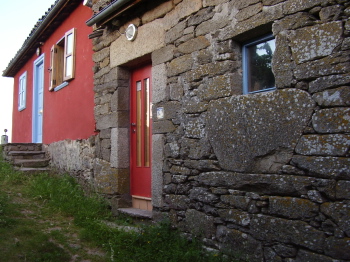 Public Opening Hours Public Opening Hours
- August 2010 – 10.30am – 1.30pm / 6 – 8.30pm (every day except Mondays). Guided Visits on requestduring opening hours – 2,50€ per adult
- Rest of the year – the craft workshops are closed to the public but you can book a guided tour or visit by appointment – T.669 600 620.
Map
|
Pago seguro
 NUEVO Octubre 2023 Curso presencial setmanal de teixits de baix lliç (Girona)!Un curso nou, setmanal (3h) a Sant Gregori, Girona, amb l'Anna Champeney. Trimensual, plaças limitadas).
Octobre 2023. Ven a aprender a diseñar y realizar tejidos en telar de bajo lizo a mano. Docente: Anna Champeney, profesional desde 2004, con marca textil propia, experta en tejido de bajo lizo, docente en la Escola Massana, Barcelona.
 Haga clic aquí para informarte |
 Spanish basket maker Lluis Grau has just spent the whole morning heating wild cherry wood poles over an open fire in the darkness of his traditional bodega or stone hut, in the Ribeira Sacra, rural Ourense, north Spain. After heating them he splits them lengthwise by hand, following the natural grain of the wood to form splints. Four neatly tied bundles of splints of wood are the result, each classified according to length. Lluis will then plane the splits using a two-handled knife – a drawknife – into smooth, even strips which are then woven together to form baskets. Lluis is one of the few traditional basketmakers in the whole of Galicia, north Spain, who still have the necessary knowledge and skills to make these baskets.
Spanish basket maker Lluis Grau has just spent the whole morning heating wild cherry wood poles over an open fire in the darkness of his traditional bodega or stone hut, in the Ribeira Sacra, rural Ourense, north Spain. After heating them he splits them lengthwise by hand, following the natural grain of the wood to form splints. Four neatly tied bundles of splints of wood are the result, each classified according to length. Lluis will then plane the splits using a two-handled knife – a drawknife – into smooth, even strips which are then woven together to form baskets. Lluis is one of the few traditional basketmakers in the whole of Galicia, north Spain, who still have the necessary knowledge and skills to make these baskets. Just across the way from where Lluis is working Anna, his partner, a hand-weaver, has finished weaving a length of cloth and has cut it from the loom. The resulting roll is satisfyingly heavy and includes enough glossy linen fabric to make several glossy linen babycapes as well as decorative stripey linen cloth made from a completely different grade of linen yarn which is very rustic in feel. To make a woven textile on a handloom today requires a minimum of ten separate processes and just setting up the loom can take a week´s work. Anna´s weave workshop is the only one in the whole of the Ribeira Sacra area of Galicia, and Lluis is one of the few basketmakers left too. Both represent traditions of making objects by hand which are centuries´ old. Although none have younger successors both have taught many pupils, both at their workshops and internationally and are committed to teaching and researching, to pass on their skills, as well as producing work for sale.
Just across the way from where Lluis is working Anna, his partner, a hand-weaver, has finished weaving a length of cloth and has cut it from the loom. The resulting roll is satisfyingly heavy and includes enough glossy linen fabric to make several glossy linen babycapes as well as decorative stripey linen cloth made from a completely different grade of linen yarn which is very rustic in feel. To make a woven textile on a handloom today requires a minimum of ten separate processes and just setting up the loom can take a week´s work. Anna´s weave workshop is the only one in the whole of the Ribeira Sacra area of Galicia, and Lluis is one of the few basketmakers left too. Both represent traditions of making objects by hand which are centuries´ old. Although none have younger successors both have taught many pupils, both at their workshops and internationally and are committed to teaching and researching, to pass on their skills, as well as producing work for sale.

 Cristosende is arguably one of the prettiest in the Ribeira Sacra (Ourense), with many tiny stone bodegas still used by local people to make wine and stunning views directly over the River Sil Canyon with its steeply-terraced, hand-worked, vineyards which produce the local mencia and godello wines. The village is not an artificial tourist village, however, but a real working village, with all the small businesses run by local families. It experiences a brief buzz during the annual fiestas, at the beginning of August, and for the rest of the year it is a haven of peace and quiet, with fewer than 40 all-year round inhabitants.
Cristosende is arguably one of the prettiest in the Ribeira Sacra (Ourense), with many tiny stone bodegas still used by local people to make wine and stunning views directly over the River Sil Canyon with its steeply-terraced, hand-worked, vineyards which produce the local mencia and godello wines. The village is not an artificial tourist village, however, but a real working village, with all the small businesses run by local families. It experiences a brief buzz during the annual fiestas, at the beginning of August, and for the rest of the year it is a haven of peace and quiet, with fewer than 40 all-year round inhabitants. Activity 1
Activity 1  Products and Description:
Products and Description:  A relaxing stroll which is a circular route along peaceful country lanes, some of which is through beautifully shady sweet chestnut groves. Print this route out as it is not signposted. It is very easy to follow and has wonderful views over the village, the vineyards and the River Sil itself. Walking is, perhaps, the best way to experience the Ribeira Sacra, and a refreshing change to car-based tourism.
A relaxing stroll which is a circular route along peaceful country lanes, some of which is through beautifully shady sweet chestnut groves. Print this route out as it is not signposted. It is very easy to follow and has wonderful views over the village, the vineyards and the River Sil itself. Walking is, perhaps, the best way to experience the Ribeira Sacra, and a refreshing change to car-based tourism.  Activity 3:
Activity 3:  After your visit to the craft workshops you can enjoy a drink or a meal (with prior reservation – (T. +34 988 20 75 29) at the attractive village manor house, the Casa Grande. The walled courtyard is refreshingly cool in summer. Another alternative is to bring your own picnic and sit out at one of the village merenderos (picnic areas), some of which have drinking fountains. Please remember to take your rubbish with you and leave the marble tables clean (Cristosende villagers like to play cards there on summer afternoons).
After your visit to the craft workshops you can enjoy a drink or a meal (with prior reservation – (T. +34 988 20 75 29) at the attractive village manor house, the Casa Grande. The walled courtyard is refreshingly cool in summer. Another alternative is to bring your own picnic and sit out at one of the village merenderos (picnic areas), some of which have drinking fountains. Please remember to take your rubbish with you and leave the marble tables clean (Cristosende villagers like to play cards there on summer afternoons). Casa dos Artesans holiday cottage (shown in photo) is ideal if you are looking for privacy, value-for-money, and space of your own. Advance bookings only. 2 spacious bedrooms. Sleeps 2 – 5 people. (585€ per week + 13.50€ for extra single bed for 5th person). (T. +34 669 600 620)
Casa dos Artesans holiday cottage (shown in photo) is ideal if you are looking for privacy, value-for-money, and space of your own. Advance bookings only. 2 spacious bedrooms. Sleeps 2 – 5 people. (585€ per week + 13.50€ for extra single bed for 5th person). (T. +34 669 600 620)  Craft Holidays – Anna Champeney, textile weaver, and Lluis Grau, basket weaver, offer residential craft holidays and courses of up to 3 weeks duration so you can combine a stay in the Ribeira Sacra with learning how to make your own hand-woven textile or basket.
Craft Holidays – Anna Champeney, textile weaver, and Lluis Grau, basket weaver, offer residential craft holidays and courses of up to 3 weeks duration so you can combine a stay in the Ribeira Sacra with learning how to make your own hand-woven textile or basket.  It´s July in the Ribeira Sacra and hand-weaver and designer, Anna Champeney, and basketmaker, Lluis Grau, are working hard in order to make their textile and basketry studios ready to open to the public during August, when they have their their summer selling exhibition and open studios. Their places of work are situated in beautifully-restored traditional stone buildings in the picturesque village of Cristosende which overlooks the famous River Sil Canyon itself. Here´s a sneak preview of what is to come when they finally open for the month of August.
It´s July in the Ribeira Sacra and hand-weaver and designer, Anna Champeney, and basketmaker, Lluis Grau, are working hard in order to make their textile and basketry studios ready to open to the public during August, when they have their their summer selling exhibition and open studios. Their places of work are situated in beautifully-restored traditional stone buildings in the picturesque village of Cristosende which overlooks the famous River Sil Canyon itself. Here´s a sneak preview of what is to come when they finally open for the month of August. Public Opening Hours
Public Opening Hours


